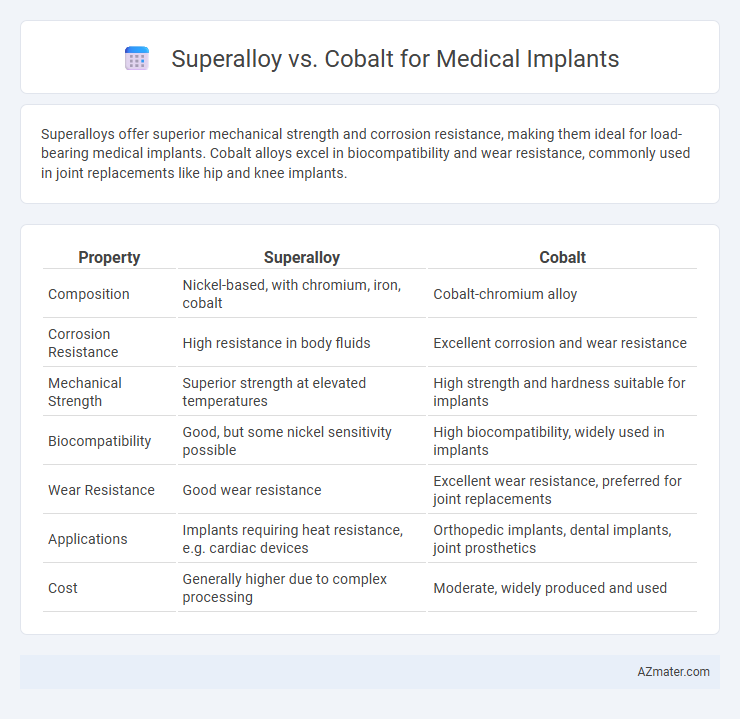Superalloys offer superior mechanical strength and corrosion resistance, making them ideal for load-bearing medical implants. Cobalt alloys excel in biocompatibility and wear resistance, commonly used in joint replacements like hip and knee implants.
Table of Comparison
| Property | Superalloy | Cobalt |
|---|---|---|
| Composition | Nickel-based, with chromium, iron, cobalt | Cobalt-chromium alloy |
| Corrosion Resistance | High resistance in body fluids | Excellent corrosion and wear resistance |
| Mechanical Strength | Superior strength at elevated temperatures | High strength and hardness suitable for implants |
| Biocompatibility | Good, but some nickel sensitivity possible | High biocompatibility, widely used in implants |
| Wear Resistance | Good wear resistance | Excellent wear resistance, preferred for joint replacements |
| Applications | Implants requiring heat resistance, e.g. cardiac devices | Orthopedic implants, dental implants, joint prosthetics |
| Cost | Generally higher due to complex processing | Moderate, widely produced and used |
Introduction to Superalloys and Cobalt in Medical Implants
Superalloys, primarily nickel- or cobalt-based, offer exceptional strength, corrosion resistance, and biocompatibility, making them ideal for medical implants such as orthopedic joint replacements and cardiovascular devices. Cobalt, often alloyed with chromium and molybdenum, is valued for its wear resistance and stability in biological environments, which ensures durability and reduced risk of inflammatory response. Both superalloys and cobalt alloys are engineered to withstand body fluids and mechanical stress, providing long-term reliability in critical medical applications.
Chemical Composition and Structure
Superalloys used in medical implants commonly consist of nickel, chromium, iron, and molybdenum, providing superior corrosion resistance and mechanical strength through a face-centered cubic (FCC) structure. Cobalt-chromium alloys feature a primarily cobalt base with significant chromium and molybdenum content, offering excellent wear resistance and biocompatibility due to their hexagonal close-packed (HCP) or FCC crystal structures. The distinct chemical compositions and microstructures of superalloys and cobalt alloys influence their durability, corrosion resistance, and compatibility with human tissue in implant applications.
Mechanical Properties Comparison
Superalloys, often based on nickel or cobalt-chromium, exhibit exceptional tensile strength, fatigue resistance, and corrosion resistance critical for long-term implant durability. Cobalt alloys, particularly cobalt-chromium-molybdenum, provide superior hardness and wear resistance, making them ideal for load-bearing implants such as joint replacements. Mechanical property comparisons reveal superalloys generally offer higher fatigue strength, while cobalt alloys excel in hardness and biocompatibility, influencing choice based on specific implant design requirements.
Corrosion Resistance in Biomedical Environments
Superalloys and cobalt-based alloys exhibit distinct corrosion resistance properties crucial for biomedical implants exposed to bodily fluids. Superalloys, often composed of nickel, chromium, and molybdenum, demonstrate excellent resistance to pitting and crevice corrosion due to the formation of stable oxide layers, enhancing implant longevity. Cobalt alloys, particularly Co-Cr-Mo variants, provide superior wear resistance and biocompatibility but may experience localized corrosion in chloride-rich environments, requiring careful surface treatments to maintain implant integrity.
Biocompatibility and Toxicity Concerns
Superalloys, typically composed of nickel, chromium, and cobalt, offer excellent mechanical strength and corrosion resistance but raise concerns regarding nickel-induced allergic reactions and long-term toxicity in medical implants. Cobalt, while also used in implants, presents lower allergenic potential but can cause cobalt ion release leading to localized toxicity and systemic effects in some patients. Both materials demand careful biocompatibility assessment, with superalloys requiring surface treatments to reduce ion leaching and cobalt alloys necessitating monitoring for ion-related adverse reactions.
Wear Resistance and Longevity
Superalloys, particularly cobalt-chromium alloys, exhibit superior wear resistance compared to pure cobalt, making them ideal for high-stress medical implants such as hip and knee replacements. The durability of these superalloys enhances implant longevity by reducing wear particle generation, which minimizes the risk of osteolysis and implant loosening. Advanced manufacturing techniques further improve the mechanical properties and biocompatibility of cobalt-based superalloys, extending the functional life of medical implants.
Manufacturing and Processing Techniques
Superalloys and cobalt-based materials differ significantly in manufacturing and processing techniques for medical implants, with superalloys often requiring advanced powder metallurgy and additive manufacturing to achieve complex geometries and superior mechanical properties. Cobalt alloys are commonly processed through casting and forging, which provide excellent wear resistance and biocompatibility but can limit design flexibility. Precision machining and surface treatments like plasma spraying are critical for both materials to enhance implant longevity and osseointegration.
Cost Analysis: Superalloy vs Cobalt
Superalloys, primarily composed of nickel, cobalt, and chromium, often present higher material and manufacturing costs compared to pure cobalt due to their complex alloying and processing requirements. Cobalt-based implants typically offer lower initial costs but may incur higher long-term expenses related to corrosion resistance and biocompatibility treatments. Cost analysis must consider not only raw material prices but also longevity, performance in biological environments, and required surface modifications for medical implants.
Clinical Applications and Case Studies
Superalloys and cobalt-based alloys both play critical roles in medical implants, with cobalt-chromium alloys favored for their superior wear resistance and biocompatibility in orthopedic applications like hip and knee replacements. Clinical case studies report that superalloys, such as titanium-based variants, exhibit excellent corrosion resistance and osseointegration, making them ideal for dental and spinal implants where long-term stability is essential. Comparative analyses highlight cobalt alloys' strength in load-bearing implants, while superalloys provide enhanced fatigue resistance, reducing implant failure rates and improving patient outcomes.
Future Trends in Medical Implant Materials
Superalloys and cobalt-based materials continue to dominate medical implant technologies due to their exceptional mechanical strength and corrosion resistance, with future trends emphasizing bioactive surface modifications to enhance osseointegration. Emerging research prioritizes lightweight, high-entropy alloys and cobalt-chromium composites with improved biocompatibility and reduced ion release to minimize adverse tissue reactions. Advances in additive manufacturing and nanotechnology integration are expected to optimize the microstructure and functional properties of these materials, driving innovation in next-generation implant performance and longevity.

Infographic: Superalloy vs Cobalt for Medical Implant
 azmater.com
azmater.com